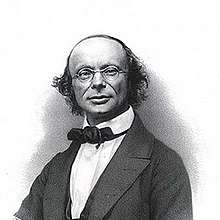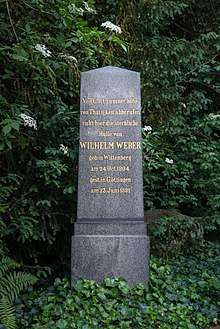Wilhelm Eduard Weber
| Wilhelm Weber | |
|---|---|
 | |
| Born |
Wilhelm Eduard Weber 24 October 1804 Wittenberg, Saxony, Holy Roman Empire |
| Died |
23 June 1891 (aged 86) Göttingen, Hanover, Prussia |
| Nationality | German |
| Alma mater |
University of Halle University of Göttingen |
| Known for |
First use of c for speed of light Work on magnetism Electrodynamometer Telegraphy |
| Awards |
Copley Medal (1859) Matteucci Medal (1879) |
| Scientific career | |
| Fields | Physics |
| Institutions |
University of Göttingen University of Halle University of Leipzig |
| Doctoral advisor | Johann Salomo Christoph Schweigger |
| Doctoral students |
Ernst Abbe Friedrich Kohlrausch Eduard Riecke |
| Other notable students |
Gottlob Frege Arthur Schuster |
| Signature | |
|
| |
| Notes | |
|
The SI unit of magnetic flux is named after him. He was the brother of Ernst Heinrich Weber and Eduard Friedrich Weber. His father was Michael Weber. | |
Wilhelm Eduard Weber (/ˈveɪbər/;[1] German: [ˈveːbɐ]; 24 October 1804 – 23 June 1891) was a German physicist and, together with Carl Friedrich Gauss, inventor of the first electromagnetic telegraph.
Biography of Wilhelm
Early years
Weber was born in Wittenberg, where his father, Michael Weber, was professor of theology. Wilhelm was the second of three brothers, all of whom were distinguished by an aptitude for science. After the dissolution of the University of Wittenberg his father was transferred to Halle in 1815. Wilhelm had received his first lessons from his father, but was now sent to the Orphan Asylum and Grammar School at Halle. After that he entered the University, and devoted himself to natural philosophy. He distinguished himself so much in his classes, and by original work, that after taking his degree of Doctor and becoming a Privatdozent he was appointed Professor Extraordinary of natural philosophy at Halle.
Career
In 1831, on the recommendation of Carl Friedrich Gauss, he was hired by the University of Göttingen as professor of physics, at the age of twenty-seven. His lectures were interesting, instructive, and suggestive. Weber thought that, in order to thoroughly understand physics and apply it to daily life, mere lectures, though illustrated by experiments, were insufficient, and he encouraged his students to experiment themselves, free of charge, in the college laboratory. As a student of twenty years he, with his brother, Ernst Heinrich Weber, Professor of Anatomy at Leipzig, had written a book on the Wave Theory and Fluidity, which brought its authors a considerable reputation. Acoustics was a favourite science of his, and he published numerous papers upon it in Poggendorffs Annalen, Schweigger's Jahrbücher für Chemie und Physik, and the musical journal Carcilia. The 'mechanism of walking in mankind' was another study, undertaken in conjunction with his younger brother, Eduard Weber. These important investigations were published between the years 1825 and 1838. Gauss and Weber constructed the first electromagnetic telegraph in 1833, which connected the observatory with the institute for physics in Göttingen.
In December 1837, the Hannovarian government dismissed Weber, one of the Göttingen Seven, from his post at the university for political reasons. Weber then travelled for a time, visiting England, among other countries, and became professor of physics in Leipzig from 1843 to 1849, when he was reinstated at Göttingen. One of his most important works, co-authored with Carl Friedrich Gauss and Carl Wolfgang Benjamin Goldschmidt, was Atlas des Erdmagnetismus: nach den Elementen der Theorie entworfen (Atlas of Geomagnetism: Designed according to the elements of the theory),[2][3] a series of magnetic maps, and it was chiefly through his efforts that magnetic observatories were instituted. He studied magnetism with Gauss, and during 1864 published his Electrodynamic Proportional Measures containing a system of absolute measurements for electric currents, which forms the basis of those in use. Weber died in Göttingen, where he is buried in the same cemetery as Max Planck and Max Born.

He was elected a foreign member of the Royal Swedish Academy of Sciences in 1855.
In 1856 with Rudolf Kohlrausch (1809–1858) he demonstrated that the ratio of electrostatic to electromagnetic units produced a number that matched the value of the then known speed of light. This finding led to Maxwell's conjecture that light is an electromagnetic wave. This also led to Weber's development of his theory of electrodynamics. Also, the first usage of the letter "c" to denote the speed of light was in an 1856 paper by Kohlrausch and Weber.
The SI unit of magnetic flux, the weber (symbol: Wb) is named after him.
See also
Notes
- ↑ "Weber". Random House Webster's Unabridged Dictionary.
- ↑ "Book Details Page: Atlas Des Erdmagnetismus: Nach Den Elementen Der Theorie Entworfen". World Ebook Fair. Retrieved 2012-08-27.
- ↑ "Atlas Des Erdmagnetismus: Nach Den Elementen Der Theorie Entworfen". Alibris. Retrieved 2012-08-27.
References
- Gauss, Carl Friedrich; Weber, Wilhelm Eduard (1840). "Atlas Des Erdmagnetismus: Nach Den Elementen Der Theorie Entworfen". Leipzig: Weidmann'sche Buchhandlung.
- G.C.F. (George Carey Foster) (1891). "Wilhelm Eduard Weber". Nature. Macmillan Journals ltd. 44 (1132): 229–230. Bibcode:1891Natur..44..229G. doi:10.1038/044229b0. Retrieved 2007-11-16. – obituary
- Urbanitsky, Alfred; Wormell, Richard (1886). "Electricity in the Service of Man". London: Cassell and Company: 756–758. – Telegraph of Weber and Gauss (with pictures)
- "Weber, Wilhelm Eduard". Virtual Laboratory. Max Planck Institute for the History of Science, Berlin. Retrieved 2007-09-05.
- Jackson, Myles W. (2006). Harmonious Triads: Physicists, Musicians, and Instrument Makers in Nineteenth-Century Germany. MIT Press. ISBN 0262276151.
External links


- "Weber, Wilhelm". New International Encyclopedia. 1905.
- "Weber, Wilhelm Eduard". Encyclopædia Britannica (11th ed.). 1911.
- "Weber, Wilhelm Eduard". The New Student's Reference Work. 1914.
- Biography and bibliography in the Virtual Laboratory of the Max Planck Institute for the History of Science
- Wilhelm Weber's Works Translated into English A bibliography compiled by A.K.T. Assis in 21st Century Science and Technology 2009-2010
- Wilhelm Eduard Weber at the Mathematics Genealogy Project
- O'Connor, John J.; Robertson, Edmund F., "Wilhelm Eduard Weber", MacTutor History of Mathematics archive, University of St Andrews .